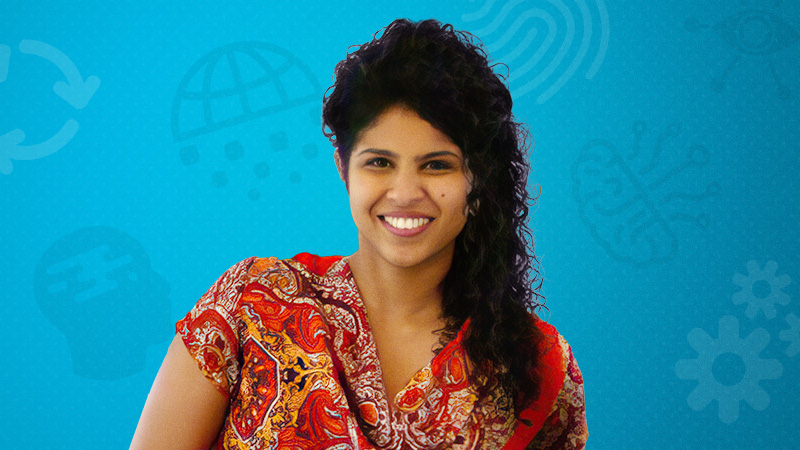This is a post by Jerome Sanders.
Failing with open ears.
Bad idea brainstorms.
Dispassionately killing each other’s ideas.
How do such concepts make for an imaginative next chapter in tech?
As Karishma Shah puts it, innovation takes a village.
Karishma Shah, who previously worked at X (formerly Google X) and Uber, now leads Ideation in Liz Centoni’s Emerging Technologies and Incubation organization. We sat down with Karishma to ask her how she defines innovation, her vision of a bolder future, and how employees can begin their own ventures.
Q: What drew you to Cisco?
Karishma: Cisco loves running towards challenging problems and consistently hires skilled individuals to solve them. I was excited to work with the talented employees, and after chatting with Cisco’s leadership team, I knew the company was committed to solving critical industrywide challenges.
Not many companies have successfully mobilized themselves to commit such attention and resources to the future state of the world, carving out space for innovators to focus on being audacious. I’m betting on Cisco to change the course of many markets over the next few years and deliver significant value to customers. I wanted to be a part of that mission.
Q: How would you describe transformational innovation?
Karishma: Transformational innovation is a rising tide that lifts all boats. It’s a radically new way of doing things that has a compound effect. This kind of innovation births an ecosystem of new companies that can create value and thrive in ways that weren’t possible before.
Take Cisco, for example. Eighty-five percent of internet traffic travels across Cisco’s networks. Our networking infrastructure laid the foundational building blocks for an entire industry of companies to be created.
Being at the forefront of this momentous transformation gave us a competitive advantage to further innovate. To this day, about 36 years later, we are still building novel products and services atop our infrastructure to better serve our customers. The seeds we planted and blossomed were transformational.
Q: What does the process of innovation look like to you?
Karishma: Innovation is a two-part process: exploration followed by experimentation. It’s successfully navigating and creating value in uncharted territory where no one has answers. When I was at Google X, we were working to figure out how to make autonomous vehicles and drone delivery possible. We had to paint a vision of a bold future that was not well understood, experiment, and create a playbook. Now both technologies are emerging in our everyday lives.
The exploration phase starts with a unique insight into a problem. This can come from anyone, anywhere, at any time. Passion and curiosity then drive innovators to persistently question “why/why not” to deconstruct the problem down to its core truths. Once these first principles are deeply understood, the innovation process switches to creative problem solving.
Initially, brainstormed solutions will naturally comprise many assumptions that build up its differentiation and value, so the core work of innovation is running mini experiments to quickly validate or discredit each assumption. Prototype testing with potential users is the best kind of experimentation.
By failing with open ears, innovators can learn what isn’t critical to users. These lessons are key as they lead to innovation with what is critical.
Q: What is your vision of how Cisco incubates ideas?
Karishma: We want to be constantly generating ideas, and I hope to champion and build the support structure for our collective ideas to see the light of day and drive impact. It’s no single person’s job to innovate — simply because it can’t be done. It takes a village. And great innovators enlist open-minded people to join them in their pursuits.
Innovating at Cisco where there are so many experts around us in different areas — from technology to product to sales — is a blessing. They can fill gaps with diverse perspectives and paint a clearer path forward.
Everyone at Cisco should contribute their unique skillsets and valuable connections, insights, and suggestions to the innovation process.
Q: Having led innovation programs at Google and Uber, what would you like to incorporate into Cisco’s culture of innovation?
Karishma: We have to foster an environment where people can be vulnerable and let their imaginations run free to share and build on raw ideas. Then, if we encourage people to experiment and fail, we can collectively uncover dead-ends that lead to either surprising insights and new ways of thinking about the problem or end it in its tracks.
At every company I’ve been at previously, we have learned to dispassionately kill ideas. Here at Cisco, I’d like us to also embrace this philosophy. We want to be open to crazy ideas and build the muscle to quickly test them, so we can objectively abandon a hypothesis that’s proven wrong to move on to more fruitful bets.
The faster we get at testing our hypotheses with the market, the more successful we will be in focusing on and rallying behind making our best ideas a reality.
Q: What would you say to an employee who doesn’t yet have an idea?
Karishma: Host a “bad idea brainstorm” with the cross-fertilization of about six people from different business groups centered on a problem you’re passionate about. You’ll be surprised how bad ideas can get built upon with diverse perspectives and take on whole new exciting forms in just an hour.
You want to gain feedback early and often, so follow up after the brainstorm with people who deeply feel the problem to learn the nuances of what needs fixing and iterate your solution. Your thinking may advance or you may go back to the drawing board. Either way is a win because innovating is a skill that gets better with practice.
By refining our innovation skills, we can all play a part in charting the course of Cisco’s future, together.
###
We welcome the re-use, republication, and distribution of "The Network" content. Please credit us with the following information: Used with the permission of http://thenetwork.cisco.com/.



